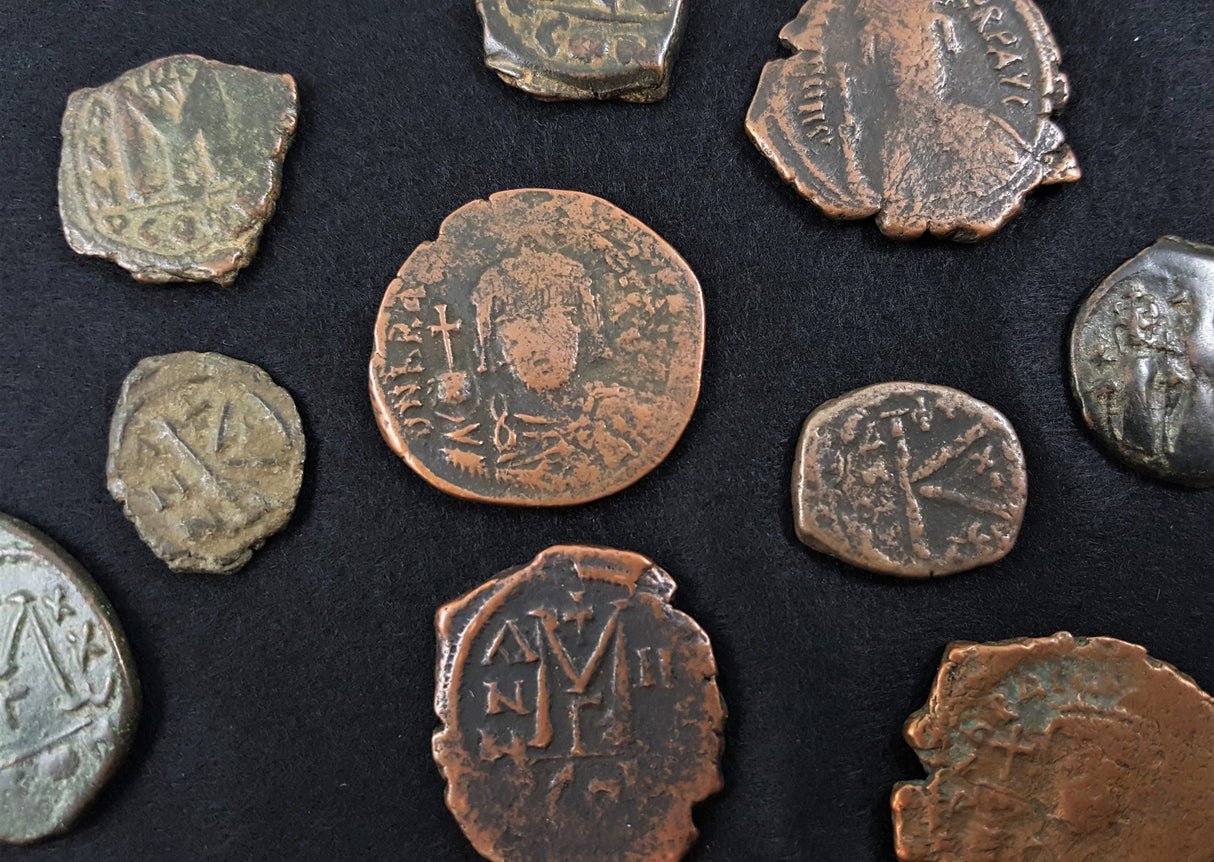 Image 1 of 2
Image 1 of 2

 Image 2 of 2
Image 2 of 2



Byzantine Follis of Constantine VII Porphyrogenitus (1066 years ago)
This bronze follis was issued during the reign of Constantine VII Porphyrogenitus, a Byzantine emperor who ruled from 913-959 AD. Minted in Constantinople (modern Istanbul, Turkey), this coin represents the monetary system of the middle Byzantine period when the Empire was experiencing a cultural renaissance. The large bronze denomination would have been used for everyday transactions by common citizens throughout the Byzantine realm.
Coin Description:
Front side: Portrait of Emperor Constantine VII wearing imperial regalia including the crown and royal garments, surrounded by a Greek inscription identifying him as the legitimate emperor.
Back side: Likely features religious Christian imagery common to Byzantine coinage of this period, possibly including a cross, Christ figure, or inscription invoking divine protection for the Empire.
Technical Details:
Bronze (AE) composition
Follis (a common bronze denomination used for everyday transactions)
Size: 27.4mm diameter, weight: 9.44g
Minted in Constantinople, capital of the Byzantine Empire
Struck between 913-959 AD during Constantine's reign
Historical Significance:
Constantine VII, known as "Porphyrogenitus" (meaning "born in the purple"), was a scholarly emperor famous for his contributions to Byzantine literature and art rather than military conquests. His reign marked a period of cultural flourishing known as the Macedonian Renaissance, during which ancient Greek texts were preserved and scholarly works commissioned. Born to Emperor Leo VI in the special purple chamber of the imperial palace (hence his epithet), Constantine faced numerous political challenges, including a regency period and co-emperors, before ruling independently. This coin circulated during a time when Byzantium maintained its position as the wealthiest state in Europe, with Constantinople serving as a major trading hub connecting East and West.
This bronze follis was issued during the reign of Constantine VII Porphyrogenitus, a Byzantine emperor who ruled from 913-959 AD. Minted in Constantinople (modern Istanbul, Turkey), this coin represents the monetary system of the middle Byzantine period when the Empire was experiencing a cultural renaissance. The large bronze denomination would have been used for everyday transactions by common citizens throughout the Byzantine realm.
Coin Description:
Front side: Portrait of Emperor Constantine VII wearing imperial regalia including the crown and royal garments, surrounded by a Greek inscription identifying him as the legitimate emperor.
Back side: Likely features religious Christian imagery common to Byzantine coinage of this period, possibly including a cross, Christ figure, or inscription invoking divine protection for the Empire.
Technical Details:
Bronze (AE) composition
Follis (a common bronze denomination used for everyday transactions)
Size: 27.4mm diameter, weight: 9.44g
Minted in Constantinople, capital of the Byzantine Empire
Struck between 913-959 AD during Constantine's reign
Historical Significance:
Constantine VII, known as "Porphyrogenitus" (meaning "born in the purple"), was a scholarly emperor famous for his contributions to Byzantine literature and art rather than military conquests. His reign marked a period of cultural flourishing known as the Macedonian Renaissance, during which ancient Greek texts were preserved and scholarly works commissioned. Born to Emperor Leo VI in the special purple chamber of the imperial palace (hence his epithet), Constantine faced numerous political challenges, including a regency period and co-emperors, before ruling independently. This coin circulated during a time when Byzantium maintained its position as the wealthiest state in Europe, with Constantinople serving as a major trading hub connecting East and West.
This bronze follis was issued during the reign of Constantine VII Porphyrogenitus, a Byzantine emperor who ruled from 913-959 AD. Minted in Constantinople (modern Istanbul, Turkey), this coin represents the monetary system of the middle Byzantine period when the Empire was experiencing a cultural renaissance. The large bronze denomination would have been used for everyday transactions by common citizens throughout the Byzantine realm.
Coin Description:
Front side: Portrait of Emperor Constantine VII wearing imperial regalia including the crown and royal garments, surrounded by a Greek inscription identifying him as the legitimate emperor.
Back side: Likely features religious Christian imagery common to Byzantine coinage of this period, possibly including a cross, Christ figure, or inscription invoking divine protection for the Empire.
Technical Details:
Bronze (AE) composition
Follis (a common bronze denomination used for everyday transactions)
Size: 27.4mm diameter, weight: 9.44g
Minted in Constantinople, capital of the Byzantine Empire
Struck between 913-959 AD during Constantine's reign
Historical Significance:
Constantine VII, known as "Porphyrogenitus" (meaning "born in the purple"), was a scholarly emperor famous for his contributions to Byzantine literature and art rather than military conquests. His reign marked a period of cultural flourishing known as the Macedonian Renaissance, during which ancient Greek texts were preserved and scholarly works commissioned. Born to Emperor Leo VI in the special purple chamber of the imperial palace (hence his epithet), Constantine faced numerous political challenges, including a regency period and co-emperors, before ruling independently. This coin circulated during a time when Byzantium maintained its position as the wealthiest state in Europe, with Constantinople serving as a major trading hub connecting East and West.
Constantine VII Porphyrogenitus (Ancient Greek: Κωνσταντῖνος Πορφυρογέννητος, Kōnstantinos Porphyrogennētos; 17 May 905 – 9 November 959) was the fourth Byzantine emperor of the Macedonian dynasty, reigning from 6 June 913 to 9 November 959. He was the son of Emperor Leo VI and his fourth wife, Zoe Karbonopsina, and the nephew of his predecessor Alexander.
Most of his reign was dominated by co-regents: from 913 until 919 he was under the regency of his mother, while from 920 until 945 he shared the throne with Romanos Lekapenos, whose daughter Helena he married, and his sons. Constantine VII is best known for the Geoponika (τά γεοπονικά), an important agronomic treatise compiled during his reign, and three, perhaps four, books; De Administrando Imperio (bearing in Greek the heading Πρὸς τὸν ἴδιον υἱὸν Ῥωμανόν),[1] De Ceremoniis (Περὶ τῆς Βασιλείου Τάξεως), De Thematibus (Περὶ θεμάτων Άνατολῆς καὶ Δύσεως), and Vita Basilii (Βίος Βασιλείου), though his authorship of the Vita Basilii is not certain.[2][3]
You Might Also Like












